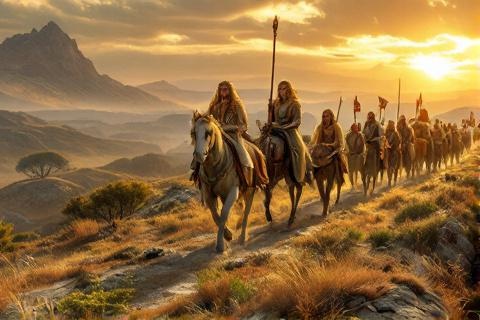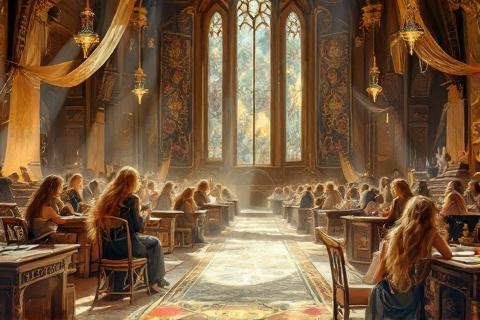
The Vanyar: Elves of Light and Legend in Tolkien's Middle-earth
Exploring the history, culture, and mysteries of the First Clan of the Elves
The First Clan: Origins of the Vanyar

The story of the Vanyar begins at Cuiviénen, the Waters of Awakening, where they
first opened their eyes to the starlit world of
Middle-earth before the First Age. As
part of the firstborn children of Ilúvatar, they were among the original
Elves who awoke beside the pristine waters in the east of
Middle-earth, where their first sight was the glittering stars placed in the
heavens by Varda.
The Vanyar were led by Ingwë, who would become their first and only High King,
maintaining this position throughout all the ages that followed. Ingwë was
recognized as the High King of all Elves, and his wisdom and nobility set the
standard for his people's behavior and aspirations. His leadership was marked by
an unwavering dedication to the will of the Valar and a deep
appreciation for the beauty and light of Aman.
The Vanyar earned their name 'the Fair Elves' due to their stunning appearance,
most notably their golden hair, which became their most distinctive physical
feature. Their beauty was remarkable even among the already beautiful Eldar,
reflecting an inner light and grace that set them apart from their kin. This
physical beauty was matched by their noble bearing and gentle nature.
Despite their significant influence on Elvish culture, the Vanyar were the
smallest in number of the three kindreds of the Eldar. Their limited numbers,
however, did not diminish their importance or their impact on the history of
Arda. Their small population may have contributed to their unity of purpose and
their ability to maintain their pure culture and traditions.
The Great Journey to Valinor

When Oromë discovered the Elves and extended the Valar's invitation to journey
to Valinor, the Vanyar were the first to accept without
hesitation. Their immediate trust in the Valar's goodwill and their desire to
see the light of the Two Trees demonstrated their inherent affinity for the
sacred and the divine. This swift acceptance characterized their unwavering
faith that would define their people throughout their history.
During the Great Journey westward, the Vanyar took the lead, showing the way for
the other Eldar with courage and determination. Their enthusiasm and steadfast
purpose helped maintain the momentum of the great migration, encouraging others
to persist despite the hardships and uncertainties of the journey. Under Ingwë's
leadership, they maintained their resolve and helped guide their fellow Elves
toward the blessed realm.
Unlike their Noldorin and Telerin kindred, who often looked back to Middle-earth
with longing or regret, the Vanyar never wavered in their commitment to Valinor.
They found complete contentment in the Blessed Realm, fully embracing their new
home among the Valar. This steadfast dedication to their choice reflected their
pure and focused nature, unmarred by doubt or divided loyalties.
Life in Valinor: The Blessed Realm

Upon reaching Valinor, the Vanyar were granted the honor of dwelling in
Taniquetil, the holy mountain where Manwë and Varda made their home. This
prestigious location reflected their special status among the Eldar and their
close relationship with the Elder King and the Star-kindler. Their presence on
the holy mountain allowed them to serve as intermediaries between the Valar and
other Elves.
The Vanyar received direct instruction from the Valar, particularly in the arts
of poetry and song. This privileged education under the guidance of the Powers
of Arda resulted in works of unprecedented beauty and sophistication. Their
poems and songs captured the divine wisdom and light of Valinor in ways that no
other Elvish works could match.
Living in the light of the Two Trees of Valinor, the Vanyar created countless
works of art celebrating their radiance. Their paintings, sculptures, and
tapestries captured the intermingling lights of Telperion and Laurelin,
preserving their beauty in artistic form. These creations served as powerful
testimonies to the splendor of the Years of the
Trees, even after their destruction by
Melkor and Ungoliant.
Through their close association with the Valar and their dedication to learning
and artistic pursuits, the Vanyar developed the most sophisticated of all Elvish
cultures. Their society combined deep spiritual awareness with artistic
excellence, creating a cultural legacy that would influence all other Elvish
realms. Their achievements in art, music, and poetry set standards that even the
skilled Noldor sought to emulate.
Culture and Characteristics
The Vanyar achieved unrivaled mastery in poetry, song, and lore, creating works
that captured the very essence of Valinor's light and beauty. Their compositions
were known for their complexity and depth, often incorporating themes of divine
wisdom and celestial light. These works remained unequaled in their ability to
convey the splendor and majesty of the Blessed Realm.
Among all the Eldar, the Vanyar were most notable for their special devotion to
the Valar, particularly to Manwë and Varda. Their dedication went beyond mere
reverence, manifesting in a deep understanding of the Valar's purposes and a
willing participation in their designs for Arda. This close relationship gave
them unique insights into the nature of the world and its sacred history.
The golden hair and fair features of the Vanyar became legendary among all the
peoples of Arda. These physical characteristics were seen as outward signs of
their inner nobility and their close connection to the light of Valinor. Their
appearance inspired countless songs and tales, even among those who had never
seen a Vanya in person.
The War of Wrath

The War of Wrath marked the only time in history when the Vanyar left Valinor
and returned to Middle-earth. This momentous departure from their peaceful
existence demonstrated their commitment to the greater good of Arda and their
loyalty to the Valar's purposes. Their participation proved crucial in the final
defeat of Morgoth.
In the host of the Valar, the Vanyar demonstrated exceptional military prowess,
leading the armies alongside the Maiar. Their natural grace and
discipline translated into remarkable skill in warfare, surprising many who had
known them only as artists and poets. Their presence struck fear into the forces
of Morgoth, for they carried with them the light and power of Valinor.
Despite their peaceful nature and preference for artistic pursuits, the Vanyar
proved to be formidable warriors when circumstances required. Their combat
abilities stemmed from their inner strength and unwavering purpose rather than
from any love of violence or conquest. Their participation in battle was viewed
as a sacred duty rather than an opportunity for glory.
Following Morgoth's defeat and imprisonment beyond the Walls of Night, the
Vanyar immediately returned to their beloved Valinor. They had no desire to
linger in Middle-earth, having fulfilled their duty in the war. Their swift
return to the Blessed Realm reinforced their reputation as the most dedicated of
all Elves to the peace and light of Valinor.
Relationships with Other Elven Kindreds
In the early days of Valinor, the Vanyar formed close alliances with the Noldor
through marriage, most notably the union between Finwë and
Indis. These marriages brought the golden hair of the Vanyar into the royal line
of the Noldor, influencing the appearance and temperament of later generations.
Such unions created lasting bonds between the two kindreds, though they would
later grow apart.
Throughout their history, the Vanyar maintained a careful distance from the
conflicts and desires that troubled other elves, particularly the Noldor's
pursuit of knowledge and power. This deliberate separation allowed them to
preserve their pure culture and unwavering focus on spiritual matters. Their
detachment from worldly concerns earned them both respect and occasional
criticism from their more engaged kin.
The Vanyar served as a living example of unwavering faith and dedication to the
divine purpose of the Valar. Their consistent choice to remain true to their
initial commitments, without being swayed by ambition or doubt, set them apart
as models of spiritual devotion. This steadfast nature became legendary among
all the peoples of Arda.
Legacy and Influence

The Vanyar came to represent the highest achievements possible for Elvish
culture, combining artistic excellence with spiritual enlightenment. Their
society in Valinor demonstrated what Elves could become when fully aligned with
the divine purpose of Eru Ilúvatar. Their accomplishments in art, music, and
poetry set standards that would never be surpassed in the history of Arda.
Through the marriages between Vanyar and Noldor, their bloodline passed down to
several notable Half-elven families, including the descendants of Elrond and
Elros. This heritage manifested in physical traits such as golden hair and in
spiritual qualities such as wisdom and foresight. The influence of Vanyarin
blood continued to shape the destiny of both Elves and Men
throughout the Ages.
Although the Vanyar never returned to Middle-earth after the War of Wrath, their
memory lived on through songs and legends. Tales of their beauty, wisdom, and
devotion inspired countless generations of Elves and Men. Their story became a
symbol of the highest aspirations of the Children of Ilúvatar.
The Vanyar remained in Valinor as eternal guardians of its sacred knowledge and
traditions. Their role as keepers of the purest Elvish culture and their
continued presence near the thrones of Manwë and Varda ensured that the wisdom
and light of the Elder Days would never be lost. They continue their vigil in
the Blessed Realm, preserving the memory of the world's first light for all
time.
